[ad_1]
A quick Google search reveals hundreds of blogging tips.
But which ones are most important?
And which ones should you follow, regardless of all the AI hype?
Well, in this post, we’re covering 21 tried and true blogging tips that just work.
They will help you:
- Get more traffic
- Build a loyal audience and community
- Know what to write about
- And earn more income.
Let’s dive in.
1. Start an Email List Early
Spencer Haws, the founder of Niche Pursuits, stated something surprising on a recent podcast episode.
Even though he grew the traffic to Niche Pursuits by 585% in 2022, he said he would still choose his email list over the blog if he had to choose one of them.
That’s a bold statement, but the truth is this: email converts!
This study shows the average ROI is $40 for every $1 spent on email marketing.
That’s why this first blogging tip is to start an email list early.
The question is:
How do you grow an email list in the early days?
Here are a few ideas to get you started.
- Create a lead magnet your readers can’t resist
- Add an exit-intent popup to capture leads
- Create a landing page and run $5 ads daily
- Read our post on how to build an email list without a website
To get started with automating your email marketing efforts, check out AWeber.
2. Build a Community

Sure, it’s important to increase blog traffic, but building a community around your blog has additional benefits.
Similar to an email list, it provides a direct way for you to communicate with your readers.
And other like-minded individuals can get in on the conversation.
Additionally, it’ll help you build your email list faster and form a stronger connection with your audience.
To start your community, try some of these:
- Get active on forums in your niche
- Answer questions on Quora
- Share your posts on social media sites
- Start a Facebook group
When you provide a lot of value on these platforms and become their go-to source of information, you’ll grow your community independently from your blog.
3. Choose the Right Niche
When you first start your blog, it’s important to find your niche or you’ll get lost in a crowded space.
Some other benefits when choosing a niche include:
1. You’ll establish topical relevance faster
2. You’re seen more as an expert when your blog helps solve a specific problem
3. It helps you connect with your readers’ because they feel like you understand them
Here’s the deal:
Big sites that cover a wide variety of topics can afford to do so because they have huge marketing budgets.
Choosing a smaller niche will help you grow your blog a lot quicker.
Why?
Because you can cover everything in a shorter amount of time, helping you gain some traction.
If you need help with this, read our post find your blog niche, or follow these quick guidelines:
- Choose a topic you’re interested in or it’ll be harder to stay motivated
- Competition is a good sign there’s money in the niche
- Niche down in the beginning, then cover broader topics later
- Find a niche with products you can review or content with commercial search intent
4. Get to Know Your Audience

Touching on the previous tips, you might notice a recurring theme.
And that is how involved you are in your niche and how well you know your audience.
If your content is quite generic because you don’t know the topics well, you won’t build a strong connection.
It’s totally fine to start a WordPress blog in a niche you know nothing about, but you’ll have better success the more you educate yourself about it.
On the flip side, knowing your audience because you live and breathe what you’re helping them with, will help you establish a much stronger connection.
5. Create a Reader Avatar
A reader avatar is an imaginary character you create that resembles your perfect reader.
This is an essential task you can do to help build rapport and connection with your audience.
Why?
This quote by psychologist Carl Rogers gives us a clue:
What is most personal is most universal.
Carl Rogers
This means that a person’s most personal problems are something we all struggle with.
When you define your blog avatar in fine detail, all of your readers will feel like you’re talking directly to them.
Start by listing things such as the basics; Name, age, gender, location, occupation, etc.
Then expand on your avatar with more details; Current challenges, goals, favorite movies, books, food, and so on.
Miles Beckler has a great post on this topic and even has a free template you can fill out.
6. Don’t Let SEO Take Over Your Life
Search Engine Optimization is an essential piece of the blogging puzzle, but try not to let it take over your life.
You could perform the perfect SEO strategy in the beginning, but it probably won’t get you far.
Let me explain.
In the early days, your blog doesn’t have any authority.
That’s because you don’t have enough content. Even 50 – 100 articles isn’t a lot of content these days.
What’s more important is publishing content every day, until you start seeing an upwards trajectory in Google Search Console.
When you’re seeing a consistent 100 visits per day, that’s a great sign things are working.
This is when you can work on more refined and advanced SEO tactics.
Be sure to read our post on how to increase organic traffic for more advanced strategies.
7. Do Perform Keyword Research
Even though a strict SEO regime isn’t vital in the beginning, it’s still important to do keyword research.
Keywords are the building blocks of your content and how Google understands it.
The last thing you want is to create tons of content that isn’t being searched by anyone.
Here are some very simple ways to perform keyword research.
Search for a term in Google and check out the People also search for section:
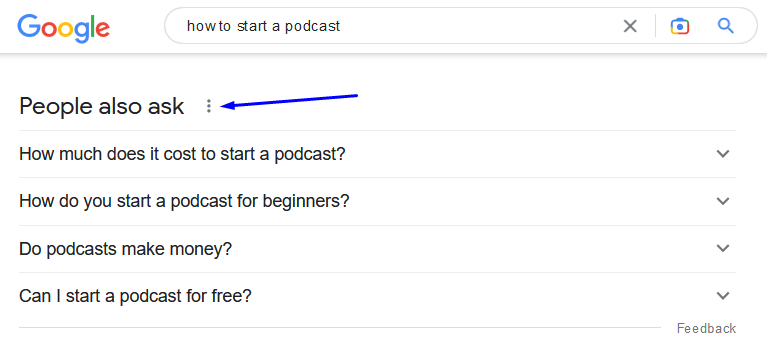
You can expand them to get even more results:
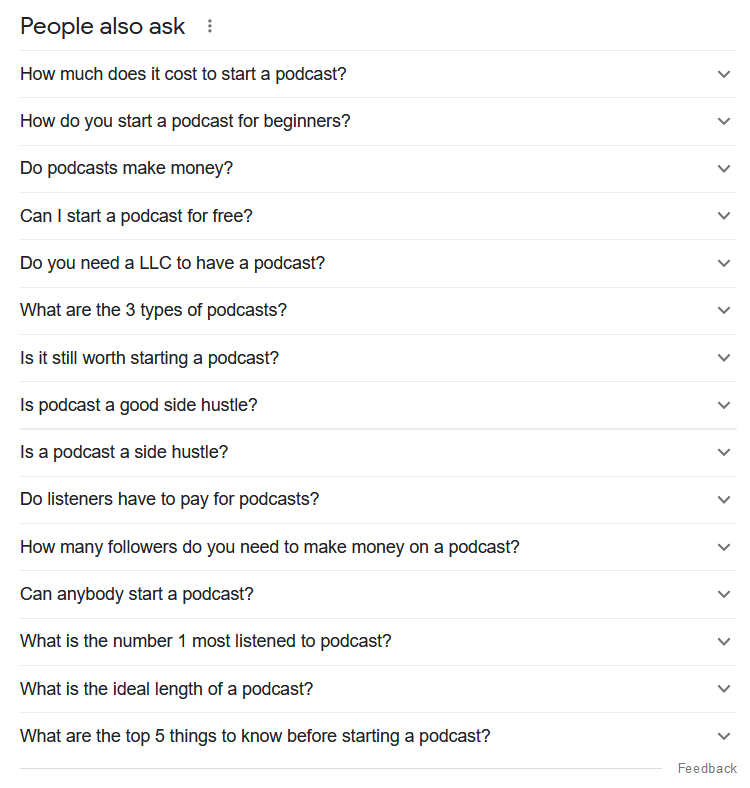
Reverse engineer your competitors’ keywords with a tool like Ubersuggest:
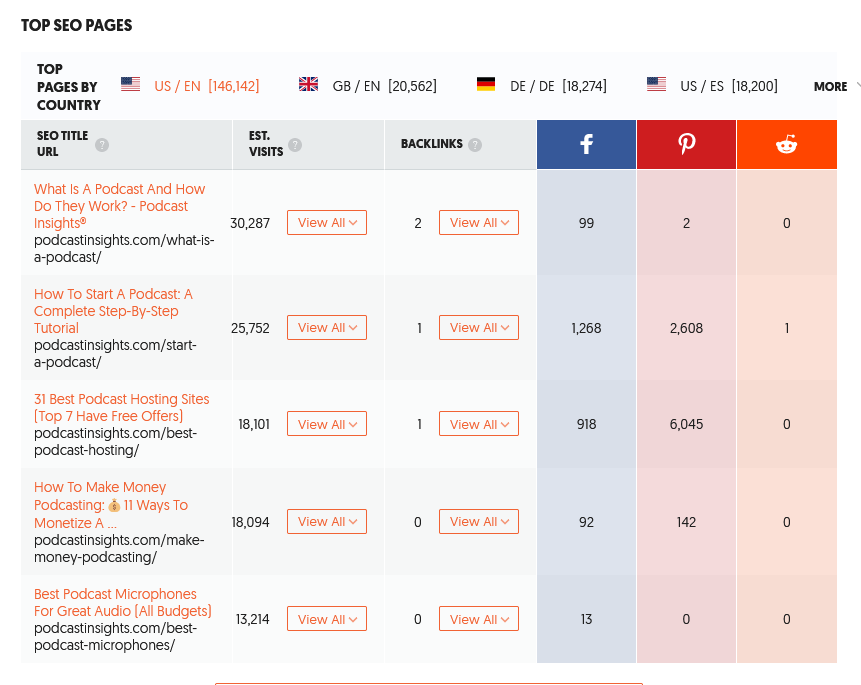
You’ll see some keywords the target site is ranking for, but you’ll need to create a free account for more results.
Find hundreds of keywords with Keywordtool.io. If you want to see the volumes, you need to upgrade.
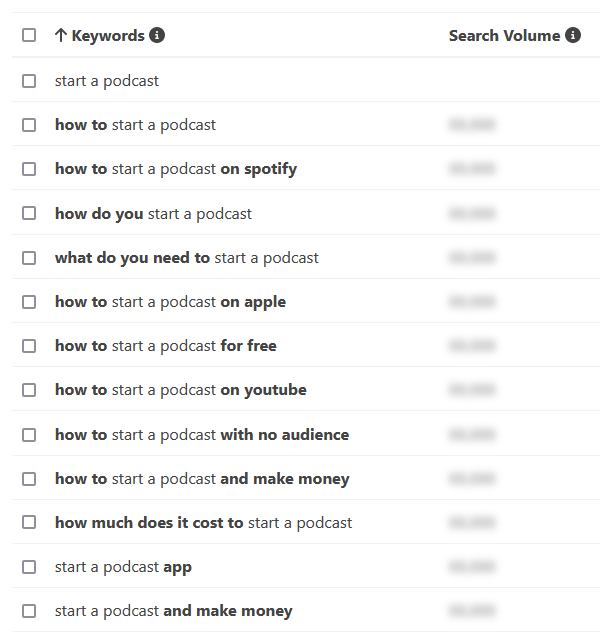
Another excellent tool for a new blog is Keywords Everywhere:
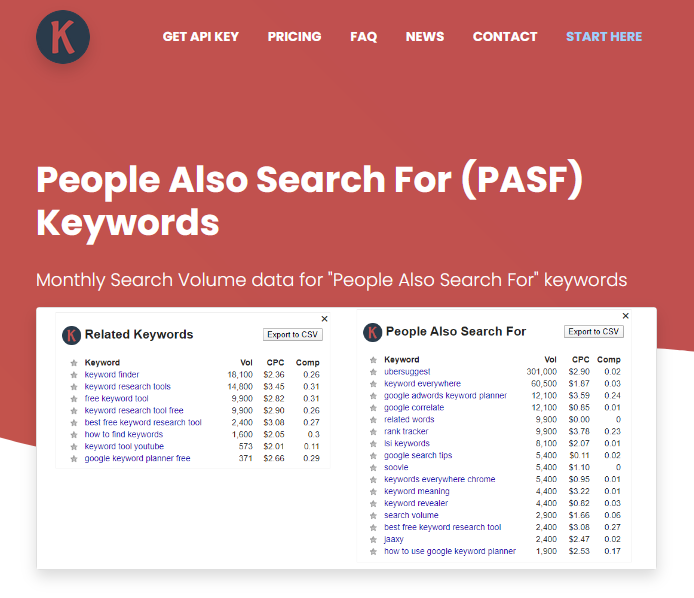
You purchase some credits, and it shows the keyword volumes everywhere in your browser.
As long as you know people are searching the content you post, the search volumes aren’t so important.
Just stick to lower volumes in the beginning, with a few high-volume keywords sprinkled in.
8. Follow Google’s Guidelines
With so many so-called SEO experts around, it can be hard to know which advice to follow.
Some will say you need a high word count per article, others rely solely on backlinks, and others jump on the newest trend such as AI writing tools.
How do you cut through all the noise?
You go to the source and that is Google.
If your most valuable traffic source is organic search, then it’s wise to know what their Google’s guidelines are.
Here are a few insights to keep you in the loop.
A great place to start is with their SEO Fundamentals. It starts with the basics of how to get your site on Google and how Google works, to in-depth tips on how to create helpful content.
Their crawling and indexing section covers all the technical side of things. This is the place to go if you want to know the difference between Sitemaps and robots.txt.
Lastly, Google blog is a good place to check now and then. They often release important updates, including this one on the recent changes to E-A-T.
9. Strategy vs Quality Content

Everyone talks about the importance of quality content, but without a strategy, you could be wasting a lot of potential.
Imagine this:
Every post on your blog is of the highest quality, but they don’t relate to each other.
Here’s the deal: successful blogging guides the reader from one post to another, teaching them how to make positive changes in their life.
Eventually, they’ve gotten so much value from your articles, they’re inspired to buy the thing you recommend. Or sign up to your email list, or buy your course.
To do this, you need a strategy.
A blog content strategy is where you plan out multiple posts that interlink with each other for optimum impact.
The purpose of effective content marketing is to raise the awareness of your readers. Awareness of their problems and what’s causing them.
When you can shift the perspective of your reader through strategic content, you’ll see substantial progress with your blog.
10. Build Internal Links
In the last blogging tip, I mentioned internal linking articles.
This is important for many reasons:
- It’s how an effective content strategy helps guide your readers
- It can also help keep people on your blog for longer
- People will see you as an expert when you link to multiple posts
- It builds topical authority in your niche, which helps your blog rank
- Your blog can rank faster with more content and internal links
As you can see, internal links provide a ton of benefits.
In fact, it’s what helped Rob Scheerbath go from zero to 33,000 pageviews in 8 months.
Link Whisper is the WordPress plugin created by Spencer Haws. It helps you create internal links on autopilot.
You can get Link Whisper here.
11. Your Blog is a Business
If you want to take your blog seriously, then you need to treat it as a business.
You can’t just load up a WordPress site and post a few articles, hoping it’ll become an overnight success.
The blogging business model needs a few ingredients to make it work.
The first step is to define how you’ll monetize your blog. This could be through affiliate marketing or by displaying ads with Ezoic.
Or maybe you want to eventually sell a digital product or service.
Either way, knowing how you’ll monetize will help you define the next step, which is knowing the types of content to create.
For affiliate marketing, you’ll want to create reviews, product comparisons, and how-to posts to support these articles.
Display ad blogs work best with question-related articles, list posts, or recipe posts.
Or if you’re selling your own products or service, case studies and interviews work well for this type of monetization.
Lastly, you’ll need to follow a system to produce content consistently. The best way to do that is by using a blog content calendar.
When you treat your blog as a business, know the main pieces of the puzzle, and produce content consistently, you’ll find it hard to fail.
12. Use Copywriting Frameworks
Copywriting frameworks are powerful ways to structure words that motivate readers to take action.
You commonly see these frameworks used in sales copy, landing pages, Facebook ads, or social media posts.
And you can bake these into your blog posts to create highly engaging content.
Some popular copywriting frameworks include:
- AIDA (Attention, Interest, Desire, Action)
- PAS (Problem, Agitate, Solution)
- BAB (Before, After, Bridge)
Not only do these frameworks grab your readers’ attention and keep them engaged, but they also help you organize your ideas and identify your target audience.
For example:
Let’s say you want to write a post about the benefits of a morning routine.
You could use the AIDA framework to engage the reader in your blog post and promote an online course at the end.
Because these frameworks use psychological principles, it makes it super easy for people to follow and it improves conversion rates.
13. Track Things to Improve

This blogging tip is essential if you want to make consistent progress with your blog.
There are key engagement metrics that you need to track to know if your blog is performing well.
Without this knowledge, you’ll never know what’s working and what isn’t.
In the beginning, it’s best to install the tracking and ignore it until you’ve posted enough content to see some traction.
A good rule of thumb is anywhere between 50-100 posts or when your blog starts getting 200+ visits per day.
Once you hit this threshold, you’ll want to keep posting content and monitor your numbers every month.
The most important numbers to track are:
- Impressions and Clicks in Google Search Console – An improvement in these metrics will tell you your content is being found and ranked in Google. And that people click the results.
- Pageviews and Average Engagement Time in Google Analytics – These metrics will help you see which content is performing best so that you can double down on them. You can also improve the content that isn’t doing so well and see if it makes an overall improvement.
14. Promote Your Blog
To increase the exposure of your blog posts, blog promotion is a great practice to adopt.
Relying solely on SEO traffic isn’t as effective.
What you need is a social media platform to promote your content.
This can be done in many ways.
For example, re-purposing your blog posts on social media is a good place to start.
Also, emailing your list when you publish new content will bring your blog more exposure.
Lastly, let other bloggers know you’ve linked to them. This is a great way to get your blog noticed by other experts in your niche.
And they might even start linking to your site in the future.
15. Be Consistent
Being consistent is possibly one of the most valuable skills to develop as a content creator.
Most people’s success comes from doing small things every day over the years, rather than aimless luck.
The issue with achieving success randomly or by luck is that it isn’t repeatable.
To get consistent success with your blog, you need to create systems that drive predictable results.
The easiest way to do that is to create big goals and break them down into tiny actions.
Then repeat these actions every day until you see positive results.
16. Update Old Blog Posts
This is a blogging tip that many people overlook.
Sure, some posts will perform better than others, but this doesn’t mean you have to completely abandon old content.
In many cases, underperforming content can be reworked from a different angle.
Or you can add more value to the post by adding more actionable steps.
Even content that once performed well might have gotten stale in recent months.
You can give these posts a new lease of life by adding images, internal links, or reformatting the text.
17. Read More Books

If you want your blog to stand out from the crowd, read more books.
What many bloggers do is share what they’ve learned from other bloggers or from content that is freely available on the internet.
The problem with this approach is that most blogs are eventually talking about the same things, with little originality.
To share a completely different perspective, you need new material.
And reading books will spark way more creativity, and you’ll find it easier to write content.
18. Diversify Income
We’ve all heard the phrase, “Don’t put all your eggs in one basket.”
And this goes for the income streams on your blog.
In the early days, it might be wise to focus on one revenue source so you stay focused.
But when you’re getting consistent traffic, you want to branch out.
So, if you started with affiliate marketing and you’re getting a decent amount of traffic, why not add display ads?
And if you’re doing both of these, how about offering a service or even coaching?
There are tons of ways to diversify income, read our post how do bloggers make money online to find out more.
19. Done is Better Than Perfect
Nothing is perfect in life. No matter how good you get, someone else can overtake you.
The point in following these blogging tips isn’t to reach perfection, only to help you improve and make progress.
It is far more effective to publish 100 mediocre articles in one year than it is to publish 12 perfect ones.
Why?
Because you will learn so much from publishing more content, even if they aren’t perfect.
With more content, you’ll start to see how Google works, and you’ll get an idea of which articles work best for you.
You’ll also develop the habits you need to become more consistent. And you’ll appreciate the process instead of trying to chase the next shiny object.
Check out what happened when Spencer published 1,000 posts in 12 months…
20. Make Posts Look Pretty
What is guaranteed to turn people away from your blog?
Ugly formatting, big walls of text, and no images.
That’s right, to keep people engaged with your content, you need to spice things up a little.
For best practices, follow these quick and simple guidelines:
- Use short 1-2 sentence paragraphs
- Break up text with subheadings, images, and bullet points
- Highlight important text with bold and italic font
- Add quotes or info boxes to grab readers’ attention
Try a combination of these and stick to the same theme throughout your blog. That way, people will know what to expect.
21. Add a Mixture of Content Types
Just like the last tip, different content types are essential for a highly engaged audience.
A variety of content types will generate more repeat visitors and can even help you rank better in search engines.
The most common types of blog content are:
- How to’s
- Product reviews
- Listicles
- Question posts
- The ultimate guide
Adding different content types will make your blog more interesting and will stop you from getting bored.
Conclusion
There you have it. These 21 blogging tips will turn you into an expert blogger in record time.
Our advice is to start with a few tips and practice them multiple times.
Then when you develop the skill, your confidence will rise, and you’ll feel more comfortable trying more advanced tips.
Good luck.
[ad_2]
Source link









